Page Content
- The Funnel Effect – Why Migratory Birds Choose Eilat
- IBRCE – International Birding & Research Center Eilat
- Migratory Birds in the Salt Ponds of Eilat
Every year the city of Eilat, in the south of Israel, hosts an international crowd of bird enthusiasts as they watch a wide assortment of migratory birds travelling between three continents – Europe, Asia and Africa.
Question: What birds fly over Eilat?
Answer: Many hundreds of millions of birds fly over Eilat annually. Among them are migratory passerines, wading birds and raptors. What is impressive is not only the number of birds, but also the variety of species that flies through.
Why Migratory Birds Choose a Path Over Eilat
Eilat is bordered by mountain ranges to the east and west and the Red Sea to the south. In addition, the surrounding region includes a number of salt ponds and water reservoirs.
Consequently the route over Eilat provides three important incentives for the birds:
- It offers an easier flight path. Geologically, Eilat lies along the Syrian-African rift that stretches from northern Syria down to central Africa. This rift serves as a corridor that contains air streams and thermals that help the birds get to their destination, while exerting less energy than that required when other paths are chosen.
- It provides a relatively safe route. Since Eilat sits on a narrow ‘over-land’ path between the three continents it offers fewer risks than the alternative Arabian desert-crossing available to the east side of the rift, or the water-crossings on the west.
- It ensures a required food supply. When the birds travel south along the rift corridor, Eilat provides a final fueling stop, before a long flight through the African desert, offering a variety of food types. Then, on the bird’s journey back north through the desert, it offers a first replenishing stop.
The Funnel Affect
The overall affect of bordering mountains and a continuous overland passage results in a funnel phenomena that steers the birds along a path that is relatively rich in food supply.
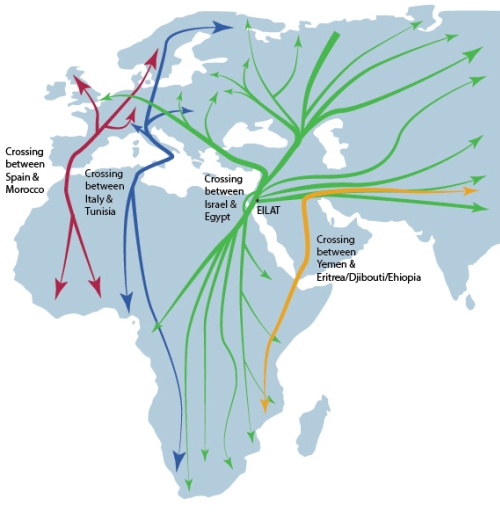
As the map above indicates, there are alternate routes used by some birds. Such paths lead these birds over water – for example, crossing between Spain and Morocco or Italy and Tunisia – or over a dry desert region – for example over Saudi Arabia and crossing into Africa from Yemen.

IBRCE – The International Birding and Research Center of Eilat
A dedicated group of ornithologists, volunteers and bird enthusiasts gather each year in Eilat in order to observe and study the habits of the many different types of birds that pass by.
The International Birding and Research Centre Eilat (IBRCE) was established as a joint venture of Israel Nature Reserves and National Parks Authority [INRNPA], Society for Protection of Nature in Israel [SPNI], Eilat Municipality [EM], Eilat Foreshore Development Co. Ltd, Jewish National Fund [KKL] and the Israel Government Tourist Corporation [IGTC].
Goals of the IBRCE Center
Its goals are to monitor and promote conservation of migratory birds in the region, to develop partnerships at international, national, and local levels, and to increase public awareness concerning the study and protection of birds. Their research involves compiling a list of regional migrant and resident species; gathering existing information on population status and trends, habitat associations, seasonal occurrences and limiting factors; assessing changes in quality and quantity of habitat types and determining species of special concern.
The grounds of the IBRCE, as a result of careful research, have been developed in such a way that each different type of bird that passes can find the food that it requires. In addition the center collaborates with international and national programs for research regarding the affect of bird migration as a whole.

Carefully designed nets and traps are set up across the grounds in order to temporarily catch the birds, enabling the researchers to examine, weigh and log them. The birds are ringed or tagged and then can be followed by other centers along the flyways, in an effort to better understand their migratory habits.
Presentation in Eilat Birding Festival about IBRCE and the migratory birds that pass over Eilat
Seminars for the Public
Seminars that are handled by the IBRCE are trying to give answers to questions like why do birds migrate at all, why are birds migrating through Eilat, why do birds prefer one route over another, how are birds able to fly thousands of kilometers within a few days, what are the methods of tracking bird migration, and many more questions.
For a discussion on international cooperation and various means of tracking migratory paths, including an explanation of stable isotopes, see our page on Migratory Birds – International Cooperation.
Presentation in Eilat Birding Festival about migration routes over Eilat

About Reed Warblers:
Living on reeds is a problem because reeds move. As you can see in the video, when the reed warbler’s body moves, the head stays still. All birds have this ability, but the reed warbler is the best example. This helps them to focus on enemies or food, despite the movement of the reeds.
You can also see that the reed warbler has a long and slender aerodynamic structure.



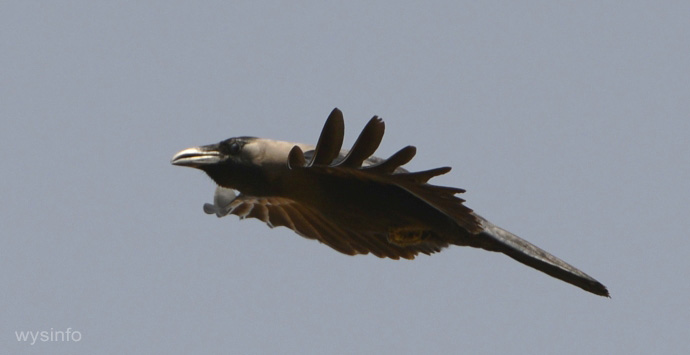
In addition to the expert ornithologists, Eilat attracts a large number of bird enthusiasts and volunteers – Read more about volunteer birders…
Migratory Birds and the Salt Ponds of Eilat
The salt ponds beside Eilat provide a source of food for migratory flamingos and other wading birds that pass over the area on their way to and from Africa.
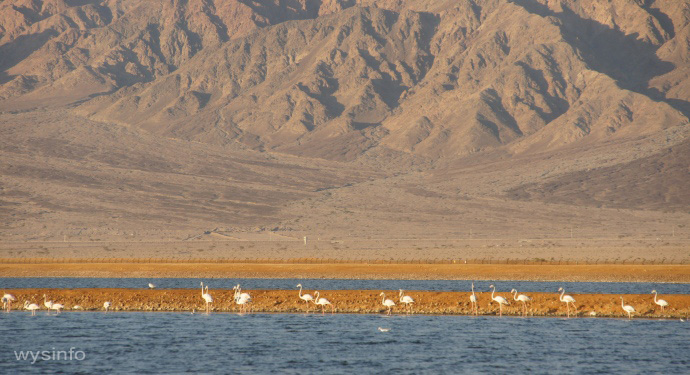
Interestingly, a group of the flamingos decided to set their home in these ponds and they no longer make the extended journey.
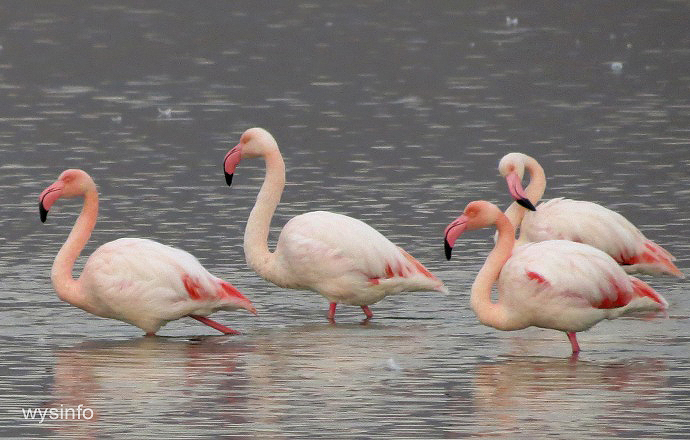
Interesting Information about Flamingos
The flamingos find, within the salt ponds, the algae which is their main source of food and also the source of their unique coloring. The algae contain carotenoid pigments which produce the pinky-red color when broken down during digestion. The young flamingos do not have the pinky coloring, but acquire it later in life.

Flamingos start flight by running a few paces, on the water, before taking off and stretching their necks forward. You can see an example of their take-off technique in the video at the top of this page.
Flamingos build nests of mud. Typically they lay only one egg per season and both mother and father watch over the egg. Also, both parents participate in feeding the chicks.
Flamingos, like pigeons and certain types of penguins, feed their young a ‘bird milk’ (also referred to as ‘crop milk’). In Flamingos this substance is produced by glands located in the upper digestive tract. This crop milk is produced by both male and female birds and is high in nutrients. You can read more about pigeon crop milk within our Pigeons and Doves docuweb in ‘The Columbidae Family’ page.
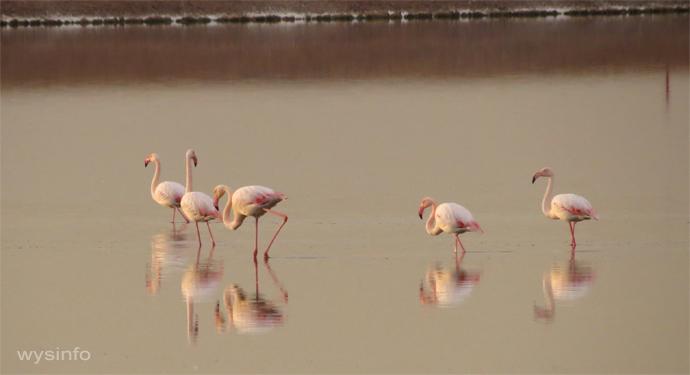
Other Wading Birds in Salt Ponds
In addition to the flamingos one finds other wading birds that are attracted to the salt ponds. Like the Flamingos, they are searching for the food that is provided in the ponds.

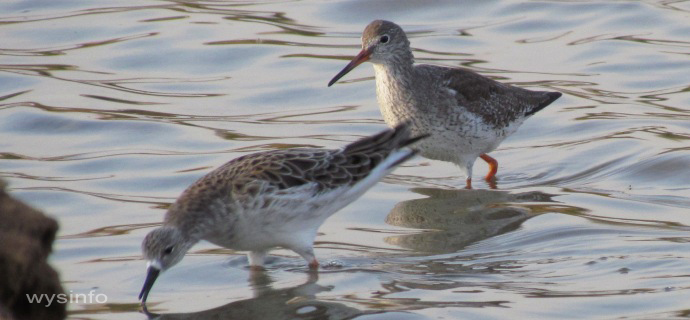
***
Related links:
***
You can also find our videos on our Wysinfo Youtube channel.